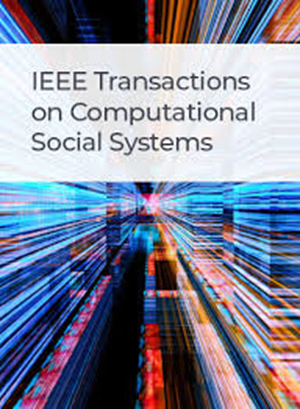基于谣言、反谣言、正谣言和动态博弈的信息传播动态模型
IF 4.5
2区 计算机科学
Q1 COMPUTER SCIENCE, CYBERNETICS
IEEE Transactions on Computational Social Systems
Pub Date : 2024-10-10
DOI:10.1109/TCSS.2024.3465023
引用次数: 0
摘要
网络谣言的传播具有复杂的动态。传统的传播模型主要基于谣言和反谣言消息,对谣言的传播情况进行静态分析。本文引入了促发谣言信息的概念,深入探讨了多类型谣言信息之间的竞争与合作。首先,考虑到多类型复合谣言消息传播的复杂性,通过提取网络结构、话题内容信息和历史行为信息,采用多元线性回归方法构建信息影响机制;然后,我们引入博弈论,并制定了一个博弈策略来捕捉谣言、反谣言和舞会谣言之间的竞争与合作。在此基础上,我们考虑了多类型复合谣言信息的交互性,并结合动态博弈构建了谣言、反谣言和正谣言的驱动机制。最后,在考虑多类型复合谣言信息的多维性和多态性的基础上,结合平均场理论和传染病模型,定义了用户状态转移方程,提出了基于谣言、反谣言、舞会谣言和动态博弈的信息传播动态模型。在真实数据验证实验中,该模型准确捕捉了多类型谣言的博弈传播过程,并预测了谣言网络中的传播趋势。本文章由计算机程序翻译,如有差异,请以英文原文为准。
Information Propagation Dynamic Model Based on Rumors, Antirumors, Prom-Rumors, and the Dynamic Game
The propagation of Internet rumors has complex dynamics. The traditional propagation model, based mainly on rumor and antirumor messages, provides a static analysis of the rumor propagation situation. This article introduces the concept of a prom-rumor (promoting rumor) message and thoroughly investigates competition and cooperation among multitype rumor messages. First, we employ a multiple linear regression method to construct the information influence mechanism by extracting network structure, topic content information, and historical behavior information, considering the complexity of spreading multitype compound rumor messages. Then, we introduce game theory and formulate a game strategy to capture the competition and cooperation among rumors, antirumors, and prom-rumors. Furthermore, we consider the interactivity in multitype compound rumor messages and combine the dynamic game to construct the driving mechanism of rumors, antirumors, and prom-rumors. Finally, we define the user-state transfer equation and propose a dynamic model of information propagation based on rumors, antirumors, prom-rumors, and the dynamic game while considering the multidimensionality and polymorphism of multitype compound rumor messages and combining mean-field theory and the infectious disease model. In validation experiments on real-life data, the model accurately captures the game propagation process of the multitype rumors and predicts the propagation trends in rumor networks.
求助全文
通过发布文献求助,成功后即可免费获取论文全文。
去求助
来源期刊

IEEE Transactions on Computational Social Systems
Social Sciences-Social Sciences (miscellaneous)
CiteScore
10.00
自引率
20.00%
发文量
316
期刊介绍:
IEEE Transactions on Computational Social Systems focuses on such topics as modeling, simulation, analysis and understanding of social systems from the quantitative and/or computational perspective. "Systems" include man-man, man-machine and machine-machine organizations and adversarial situations as well as social media structures and their dynamics. More specifically, the proposed transactions publishes articles on modeling the dynamics of social systems, methodologies for incorporating and representing socio-cultural and behavioral aspects in computational modeling, analysis of social system behavior and structure, and paradigms for social systems modeling and simulation. The journal also features articles on social network dynamics, social intelligence and cognition, social systems design and architectures, socio-cultural modeling and representation, and computational behavior modeling, and their applications.
 求助内容:
求助内容: 应助结果提醒方式:
应助结果提醒方式:


